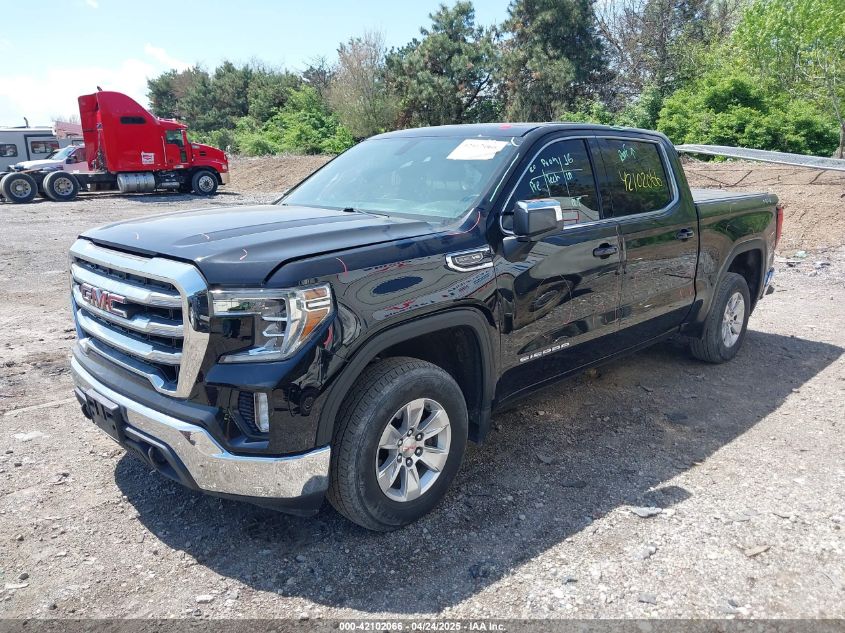2021 FORD EXPLORER | 1FM5K8HC1MGA46314
2021 FORD EXPLORER | 1FM5K8HC1MGA46314
Specifications
4
~$58,000
Engine: 3.0L twin-turbocharged V6
Torque: 563 Nm
0–100 km/h: ~5.3 s
The Ford Explorer ST represents one of the most performance-focused entries in the three-row SUV segment. Its 3.0L twin-turbocharged EcoBoost V6 delivers 400 horsepower and 563 Nm of torque, enabling a 0–100 km/h sprint in just 5.3 seconds — territory typically reserved for luxury performance SUVs. The 10-speed automatic transmission responds quickly and intuitively, while standard AWD ensures confident launches and year-round grip.
The ST variant rides on a sport-tuned suspension that reduces body roll and sharpens response without sacrificing ride comfort for daily use. Steering is well-weighted and precise, particularly in Sport mode, which also adjusts throttle mapping and transmission behavior. With beefed-up brakes and stiffer chassis tuning, the Explorer ST feels genuinely athletic despite its size, remaining composed through high-speed curves and brisk transitions.
Ford’s approach to performance in the Explorer balances family practicality with muscular capability. The ST doesn’t just look aggressive — it delivers real power and composure, making it one of the few three-row SUVs that can double as a spirited weekend driver.
Body Styles
The Ford Explorer is a midsize three-row SUV with rear-wheel-drive architecture and bold, muscular proportions. The 2020 redesign shifted the platform to longitudinal engine mounting, improving handling and towing capability. The body features a long hood, sloping roofline, prominent shoulder lines, and a slightly tapered rear end for improved aerodynamics. With a 3025 mm wheelbase, it offers ample interior space and balanced proportions. The upright grille, C-shaped LED daytime running lights, and sculpted tailgate give it a tough yet refined aesthetic, with trim-specific details ranging from blacked-out accents on the ST to satin aluminum on Platinum models.
Model Name Meaning (Manufacturer)
The name “Explorer” reflects Ford’s intent to market the vehicle as a versatile and adventurous SUV, capable of transporting families to new destinations while symbolizing freedom and travel. Introduced in 1990, the Explorer helped define the modern SUV segment and continues to represent exploration and capability.
Model Name Meaning (Languages)
“Explorer” is a familiar word in English and many other languages, symbolizing discovery, adventure, and movement. Its connotations are universally positive and align naturally with the SUV’s image of rugged freedom, giving it strong marketing resonance in global markets.
Body & Interior Colors and Rims
The Explorer is available in a broad palette including Agate Black, Iconic Silver, Rapid Red, Infinite Blue, Stone Blue, Star White, Forged Green, and Carbonized Gray. ST and Timberline trims add unique colors and styling elements, including gloss black grilles, red brake calipers, and black roof rails. Platinum trims add satin chrome, while Timberline variants feature higher ground clearance, skid plates, and more rugged accents.
Inside, the Explorer offers a spacious and modern cabin with materials and trims varying by model. Base models feature cloth and soft-touch plastics, while ST and Platinum models introduce leather upholstery with contrast stitching, carbon fiber or wood accents, ambient lighting, and available quilted inserts. Seating options include second-row captain’s chairs or a bench, with third-row access enhanced by sliding second-row seats. A 12.3-inch digital instrument cluster, portrait-style 10.1-inch touchscreen (on select trims), and wireless charging enhance usability, while tri-zone climate, power-folding third-row seats, and Bang & Olufsen audio elevate higher trims.
Wheel designs range from 18-inch aluminum on base and Timberline trims to 20-inch black or machined-face alloys on ST, with 21-inch premium wheels available on top-end Platinum. Each design complements the trim's aesthetic — rugged, sporty, or elegant — with appropriate finishes and patterns.
Top Expensive Options
- Premium Technology Package (10.1" Touchscreen + B&O Audio): $1,200
- 12.3-inch Digital Instrument Cluster: $750
- Multicontour Massage Front Seats: $995
- Twin-Panel Moonroof with Power Sunshade: $1,695
- ST Street Pack (Performance Brakes + 21" Wheels): $1,595
- Tow Technology Package with Trailer Assist: $995
- Enhanced Active Park Assist: $600
- Adaptive Cruise Control with Stop & Go: $795
- Leather Seating with Micro-Perforation and Ventilation: $1,500
- Wireless Phone Charging and 4 USB Ports: $350
vs Competitors
The Ford Explorer faces off with the Honda Pilot, Kia Telluride, Hyundai Palisade, Toyota Grand Highlander, and Chevrolet Traverse, yet stands out for its rear-wheel-drive architecture and turbocharged engine options. This layout gives it better towing capability, balanced weight distribution, and stronger acceleration — especially in the ST and Platinum trims. Against the Telluride and Palisade, the Explorer offers more driving excitement but less interior refinement. Compared to the Highlander, it has a stronger drivetrain lineup but less fuel efficiency. The Traverse rivals it in size but falls short in handling precision and trim diversity. Overall, the Explorer blends utility, performance, and tech in a way few midsize three-row SUVs manage — particularly for those prioritizing driving dynamics.
Fun Fact
The 2020 redesign marked the return of rear-wheel drive to the Explorer for the first time in nearly a decade, enhancing towing, weight distribution, and sportiness. It's also one of the only vehicles in its class to offer a dedicated performance model (ST) and an off-road variant (Timberline) — giving buyers uniquely tailored flavors of adventure or athleticism under one SUV nameplate.
Lot Details
-
Sale Date21/Jun/2025
-
Lot Number42310141
-
Sale document
-
Location
-
Odometer1 miles (2 km)
-
Primary Damage:ROOF
-
Seller
-
Fuel
-
Engine Type3.0L V-6 DI, DOHC, VVT, turbo, 365HP
-
Transmission
-
Drive Type
-
Color
Final Bid Ford Explorer (2021)
$10,000
$13,541
$36,750
Specifications
4
~$58,000
Torque:
0–100 km/h:
The Ford Explorer ST represents one of the most performance-focused entries in the three-row SUV segment. Its 3.0L twin-turbocharged EcoBoost V6 delivers 400 horsepower and 563 Nm of torque, enabling a 0–100 km/h sprint in just 5.3 seconds — territory typically reserved for luxury performance SUVs. The 10-speed automatic transmission responds quickly and intuitively, while standard AWD ensures confident launches and year-round grip.
The ST variant rides on a sport-tuned suspension that reduces body roll and sharpens response without sacrificing ride comfort for daily use. Steering is well-weighted and precise, particularly in Sport mode, which also adjusts throttle mapping and transmission behavior. With beefed-up brakes and stiffer chassis tuning, the Explorer ST feels genuinely athletic despite its size, remaining composed through high-speed curves and brisk transitions.
Ford’s approach to performance in the Explorer balances family practicality with muscular capability. The ST doesn’t just look aggressive — it delivers real power and composure, making it one of the few three-row SUVs that can double as a spirited weekend driver.
Body Styles
The Ford Explorer is a midsize three-row SUV with rear-wheel-drive architecture and bold, muscular proportions. The 2020 redesign shifted the platform to longitudinal engine mounting, improving handling and towing capability. The body features a long hood, sloping roofline, prominent shoulder lines, and a slightly tapered rear end for improved aerodynamics. With a 3025 mm wheelbase, it offers ample interior space and balanced proportions. The upright grille, C-shaped LED daytime running lights, and sculpted tailgate give it a tough yet refined aesthetic, with trim-specific details ranging from blacked-out accents on the ST to satin aluminum on Platinum models.
Model Name Meaning (Manufacturer)
The name “Explorer” reflects Ford’s intent to market the vehicle as a versatile and adventurous SUV, capable of transporting families to new destinations while symbolizing freedom and travel. Introduced in 1990, the Explorer helped define the modern SUV segment and continues to represent exploration and capability.
Model Name Meaning (Languages)
“Explorer” is a familiar word in English and many other languages, symbolizing discovery, adventure, and movement. Its connotations are universally positive and align naturally with the SUV’s image of rugged freedom, giving it strong marketing resonance in global markets.
Body & Interior Colors and Rims
The Explorer is available in a broad palette including Agate Black, Iconic Silver, Rapid Red, Infinite Blue, Stone Blue, Star White, Forged Green, and Carbonized Gray. ST and Timberline trims add unique colors and styling elements, including gloss black grilles, red brake calipers, and black roof rails. Platinum trims add satin chrome, while Timberline variants feature higher ground clearance, skid plates, and more rugged accents.
Inside, the Explorer offers a spacious and modern cabin with materials and trims varying by model. Base models feature cloth and soft-touch plastics, while ST and Platinum models introduce leather upholstery with contrast stitching, carbon fiber or wood accents, ambient lighting, and available quilted inserts. Seating options include second-row captain’s chairs or a bench, with third-row access enhanced by sliding second-row seats. A 12.3-inch digital instrument cluster, portrait-style 10.1-inch touchscreen (on select trims), and wireless charging enhance usability, while tri-zone climate, power-folding third-row seats, and Bang & Olufsen audio elevate higher trims.
Wheel designs range from 18-inch aluminum on base and Timberline trims to 20-inch black or machined-face alloys on ST, with 21-inch premium wheels available on top-end Platinum. Each design complements the trim's aesthetic — rugged, sporty, or elegant — with appropriate finishes and patterns.
Top Expensive Options
- Premium Technology Package (10.1" Touchscreen + B&O Audio): $1,200
- 12.3-inch Digital Instrument Cluster: $750
- Multicontour Massage Front Seats: $995
- Twin-Panel Moonroof with Power Sunshade: $1,695
- ST Street Pack (Performance Brakes + 21" Wheels): $1,595
- Tow Technology Package with Trailer Assist: $995
- Enhanced Active Park Assist: $600
- Adaptive Cruise Control with Stop & Go: $795
- Leather Seating with Micro-Perforation and Ventilation: $1,500
- Wireless Phone Charging and 4 USB Ports: $350
vs Competitors
The Ford Explorer faces off with the Honda Pilot, Kia Telluride, Hyundai Palisade, Toyota Grand Highlander, and Chevrolet Traverse, yet stands out for its rear-wheel-drive architecture and turbocharged engine options. This layout gives it better towing capability, balanced weight distribution, and stronger acceleration — especially in the ST and Platinum trims. Against the Telluride and Palisade, the Explorer offers more driving excitement but less interior refinement. Compared to the Highlander, it has a stronger drivetrain lineup but less fuel efficiency. The Traverse rivals it in size but falls short in handling precision and trim diversity. Overall, the Explorer blends utility, performance, and tech in a way few midsize three-row SUVs manage — particularly for those prioritizing driving dynamics.
Fun Fact
The 2020 redesign marked the return of rear-wheel drive to the Explorer for the first time in nearly a decade, enhancing towing, weight distribution, and sportiness. It's also one of the only vehicles in its class to offer a dedicated performance model (ST) and an off-road variant (Timberline) — giving buyers uniquely tailored flavors of adventure or athleticism under one SUV nameplate.









